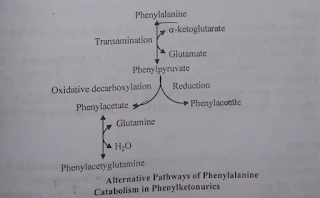phenylketonuria is a congenital or inborn error of phenylalanine metabolism, related to the inability to convert phenylalanine to tyrosine. The PKU is a genetic disorder and is inherited in an autosomal recessive manner. The rate of incidence of classic PKU is about 1 in 20,000 new-borns.
In phenylalanine hydroxylase deficiency, phenylalanine is accumulated in tissues and blood. Thus, the new-born excretes excess phenylalanine in the urine. In PKU, the phenylalanine conversion to tyrosine through normal pathway does not occur but some minor pathway becomes active in phenylketonuria and various toxic phenylalanine metabolites (like phenylpyruvate, phenylacetate, phenyl lactate and phenylacetylglutamine) are accumulated in the body.
The disease is termed untreated PKU because of elevated keto acid, phenylpyruvate in the urine.
Types
PKU can be classified into three broad categories. The deficiency of Phenylalanine hydroxylase is the most common cause of the error.
Types of phenylketonuria with their defects
|
Types of PKU |
Defects |
|
Classic phenylketonuria
or Hyperphenylalaninemia
type-I |
Defect in
phenylalanine hydroxylase |
|
Atypical phenylketonuria
or Hyperphenylalaninemia
type-II and III |
Defect in
dihydrobiopterin reductase |
|
Hyperphenylalaninemia
type-IV and V |
Defect in
dihydrobiopterin synthesis |
Cause
PKU is an inherited condition and is caused by a defective PAH gene. The mutations in the pah gene are responsible for phenylalanine hydroxylase, the enzyme required for the catabolism of phenylalanine. Thus, if someone eats an excess of a high-protein diet (eggs, meat, etc.), phenylalanine gets accumulated to a dangerous level.
Symptoms
1) Mental retardation or intellectual disability,
2) Delayed development,
3) Behavioural, emotional, and social problems,
4) Psychiatric disorders,
5) Neurological problems that may include seizures,
6) Hyperactivity,
7) Poor bone strength,
8) Skin rashes (eczema),
9) A musty odor in the child's breath, women with PKU skin or urine, caused by too much phenylalanine in the body,
10)Fair skin and blue eyes because phenylalanine cannot transform into melanin, (pigment providing hair and skin color), and
11)Abnormally small head (microcephaly).
Diagnosis
1) Urine of neonate is assayed by adding FeCl3, which gives an olive color in the presence of phenylpyruvate.
2) The blood level of phenylalanine is detected by the Guthrie test, a bacterial assay for phenylalanine. It is a more reliable diagnostic test for phenylalanine.
3) Now, the gene responsible for human phenylalanine hydroxylase has been cloned, so the prenatal diagnosis of PKU can be performed with DNA probes also.
Treatment
1) Treatment of PKU involves a low phenylalanine diet. The aim is to provide just enough phenylalanine required for growth and replacement.
2) Intake of protein with low content of phenylalanine, for example, casein proteins from milk have less phenylalanine. The casein proteins are hydrolyzed and phenylalanine is removed by adsorption.
3) A diet having low phenylalanine content prescribed soon after birth to halt the irreversible brain damage.
In severe cases of PKU, 5-hydroxytryptophan (5-HT) and dopa are prescribed to restore the synthesis of serotonin and catecholamines.
Albinism is a group of conditions, in which error occurs in tyrosine metabolism and thus defective melanin synthesis occurs. Such individuals have little or no color (pigment) in the skin, hair, and eyes.
Types
1) Type I Albinism: In this, defects occur in the production of melanin pigment.
2) Type Il Albinism: In this type of albinism, the defect occurs in the "P" mutated gene. At birth, a light coloring is observed. Subtypes of this category of albinism are:
i) Oculocutaneous Albinism oca: It is the most severe form of albinism child with albinism and people with albinism. Patients are observed with white or pink hair, skin, and iris color. Such patients also suffer from vision problems.
ii) Ocular Albinism Type 1(OA1): It affects only the optic nerves of the eyes. The skin and eye color are generally in the normal range, but the absence of color is examined in the backside (retina) of the eye.
iii) Hermansky-Pudlak Syndrome (HPS): It is a single gene defect and occurs with the bleeding disorder as well as with lung and bowel diseases.
Cause
Albinism occurs when the production or distribution of melanin is disturbed. One of several gene defects that causes albinism. Melanin is a natural substance imparting color to hair, skin, and iris of the eye.
Symptoms
1) Any obstruction in melanin production causes hypo-pigmentation or no pigmentation (white hair, skin, and eyes colors become white).
2) Albinos or individuals with light skin color are sensitive to light and the chances of skin cancer are more in such individuals.
3) Lack of melanin pigment in the eyes causes photophobia (intolerance to light) and nystagmus.
Diagnosis
1) Physical Evaluation: It is a less accurate way of detecting albinism and includes evaluation of symptoms of albinism.
2) Electroretinogram Test: This test reveals the eye problems associated with albinism. It measures the response of light-sensitive cells in the eyes.
3) Genetic Testing: It is the most accurate way to diagnose albinism and is used to detect defective genes related to albinism.
Treatment
Albinism cannot be cured but its treatment may relieve symptoms and prevent sun damage. Following measures should be taken by an albinism patient:
1) Sunglasses to protect the eyes from UV rays,
2) Protective clothing and sunscreen to protect the skin from UV rays,
3) prescription eyeglasses to correct vision problems, and
4) Surgery of the muscles' eye to correct abnormal eye movements.
For more pharmacy notes-
Visit;












No comments:
Post a Comment